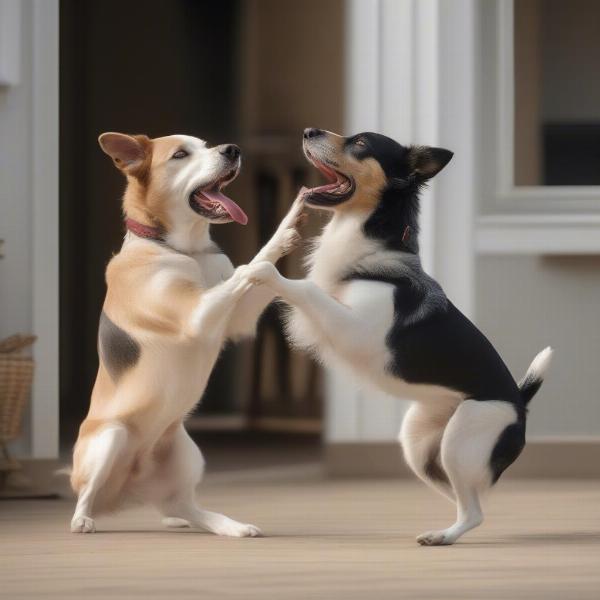Dog greetings can be a source of both joy and confusion. Whether you’re a seasoned dog owner or just starting out, understanding how dogs greet each other, and how they greet humans, is crucial for fostering positive interactions and avoiding potential misunderstandings. This guide will delve into the nuances of canine communication, covering everything from body language cues to common greeting rituals.
Decoding Canine Body Language in Greetings
A dog’s greeting isn’t just a wagging tail and a sniff. It’s a complex interplay of subtle signals that communicate their intentions. A relaxed, friendly greeting typically involves a loose, wiggling body, a slightly open mouth with a relaxed pant, and a playful bow. Avoidant dogs might avert their gaze, tuck their tail, lick their lips, and yawn excessively, indicating discomfort or fear. On the other hand, a stiff posture, raised hackles, direct stare, and a growl signal aggression or dominance.
Recognizing Signs of Stress During Greetings
Not all greetings are positive. Some dogs can become overwhelmed or stressed, especially in unfamiliar situations. Recognizing signs of stress is key to preventing negative experiences. Look for lip licking, whale eye (showing the whites of their eyes), tucked tails, and attempts to hide or move away. If you observe these signs, give the dog space and allow them to retreat.
How to Greet a Dog Properly
Approaching a dog correctly is essential for a positive interaction. Avoid direct eye contact, which can be perceived as a challenge. Instead, turn your body slightly sideways and approach calmly, speaking in a soft, gentle voice. Extend your hand with your fingers curled inwards, allowing the dog to sniff you before attempting to pet them.
Common Mistakes to Avoid When Greeting Dogs
Many well-intentioned people make mistakes when greeting dogs, inadvertently causing stress or fear. Avoid reaching over the dog’s head, hugging them tightly, or approaching them too quickly. These actions can be intimidating and might trigger a defensive reaction. Remember, every dog is an individual, and some may be more sensitive than others.
Dog-to-Dog Greetings: A Complex Dance
Dog-to-dog greetings involve a delicate dance of communication. Dogs often circle each other, sniffing noses and rear ends, gathering information about the other dog’s identity, health, and social status. Play bows, where the front end is lowered and the rear end is raised, are invitations to play and a sign of friendly intentions.
 Dog-to-Dog Greeting Play Bow
Dog-to-Dog Greeting Play Bow
Why Understanding Dog Greetings is Important
Understanding dog greetings is crucial for promoting positive interactions and preventing potential conflicts. By learning to interpret canine body language and approaching dogs appropriately, you can contribute to a safer and more enjoyable experience for both dogs and humans. Remember, a well-socialized dog is a happy dog, and proper greetings are the foundation of healthy social interactions.
Conclusion
Dog greetings are more than just a quick hello; they are a complex language that reflects a dog’s emotional state and intentions. By understanding the nuances of this language, we can foster positive interactions and create a harmonious environment for our canine companions. Remember to approach dogs calmly, respect their space, and observe their body language to ensure a safe and enjoyable greeting for everyone involved.
FAQs
-
Why does my dog greet some dogs excitedly and others with caution? Dogs, like humans, have individual personalities and preferences. Past experiences, social skills, and even breed can influence how a dog reacts to other dogs.
-
How can I help my dog greet other dogs appropriately? Socialization is key. Expose your dog to a variety of dogs in a controlled and positive environment. Reward calm behavior and provide guidance when needed.
-
What should I do if my dog shows signs of fear or aggression during greetings? Consult with a certified professional dog trainer or behaviorist. They can help identify the root cause of the behavior and develop a tailored training plan.
-
Is it always necessary to let dogs greet each other? No. Not all dogs enjoy or benefit from greeting every dog they encounter. Respect their individual preferences and prioritize their comfort.
-
How can I tell if a dog’s greeting is playful or aggressive? Observe the dog’s overall body language. Playful greetings involve loose, wiggly bodies, play bows, and relaxed facial expressions. Aggressive greetings are characterized by stiff postures, direct stares, growls, and raised hackles.
ILM Dog is your trusted resource for all things dog-related. We offer expert advice on dog breeds, health, training, nutrition, grooming, and much more. Whether you’re a new dog owner or a seasoned pro, ILM Dog is dedicated to providing you with the information and resources you need to care for your canine companion. Contact us at [email protected] or +44 20-3965-8624 for personalized support.